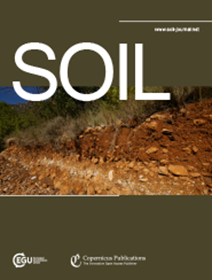微生物燃料电池运行下水稻土Cr(VI)还原、产电及微生物耐药性变化
IF 4.3
2区 农林科学
Q1 SOIL SCIENCE
引用次数: 0
摘要
摘要。微生物燃料电池(MFC)是一种有效的就地对抗污染物和发电的方法。本研究通过构建土壤MFC (SMFC)来降低水稻土中Cr(VI),并研究其对微生物群落和微生物抗性特性的影响。Fe3O4纳米颗粒作为阴极催化剂,可有效提高发电效率(0.97 V, 102.00 mW m−2),其多孔结构和还原性也有助于铬(Cr)的还原和固定化。30d后,Cr(VI)的去除率为93.67%。生物有效态Cr减少97.44%,残留态Cr增加88.89%。SMFC操作极大地改变了土壤的酶活性和微生物结构,在1000倍以上的土壤中存在着像Desulfotomaculum(阳极3.32%)和像Hydrogenophaga(阴极2.07%)这样的Cr(VI)还原菌。特别是SMFC操作显著提高了重金属抗性基因(HRG)的丰度。其中,在SMFC阳极中,chrA、chrB和chrR增加了99.54% - 3314.34%,这可能是由于不动杆菌、Limnohabitans和Desulfotomaculum等潜在耐受性菌的富集。这些关键类群与hrg呈显著正相关,与pH、电导率(EC)、Cr(VI)呈显著负相关,可能是导致Cr(VI)还原的原因。该研究为生物电化学系统在污染水稻土中的应用提供了新的证据,为环境修复和脱毒提供了潜在的途径。本文章由计算机程序翻译,如有差异,请以英文原文为准。
Cr(VI) reduction, electricity production, and microbial resistance variation in paddy soil under microbial fuel cell operation
Abstract. The microbial fuel cell (MFC) is an efficient in situ approach to combat pollutants and generate electricity. This study constructed a soil MFC (SMFC) to reduce Cr(VI) in paddy soil and to investigate its influence on microbial community and microbial resistance characteristics. Ferroferric oxide (Fe3O4) nanoparticles, as the cathodic catalyst, effectively boosted power generation (0.97 V, 102.00 mW m−2), with the porous structure and reducibility also contributing to chromium (Cr) reduction and immobilization. After 30 d, 93.67 % of Cr(VI) was eliminated. The bioavailable Cr decreased by 97.44 %, while the residual form increased by 88.89 %. SMFC operations greatly changed soil enzymatic activity and microbial structure, with exoelectrogens like Desulfotomaculum (3.32 % in the anode) and Cr(VI)-reducing bacteria like Hydrogenophaga (2.07 % in the cathode) in more than 1000 folds of soil. In particular, SMFC operations significantly enhanced heavy-metal resistance gene (HRG) abundance. Among them, chrA, chrB, and chrR increased by 99.54 %–3314.34 % in SMFC anodes, probably attributable to the enrichment of potential tolerators like Acinetobacter, Limnohabitans, and Desulfotomaculum. These key taxa were positively correlated with HRGs but were negatively correlated with pH, electrical conductivity (EC), and Cr(VI), which could have driven Cr(VI) reduction. This study provided novel evidence for bio-electrochemical system applications in contaminated paddy soil, which could be a potential approach for environmental remediation and detoxification.
求助全文
通过发布文献求助,成功后即可免费获取论文全文。
去求助
来源期刊

Soil
Agricultural and Biological Sciences-Soil Science
CiteScore
10.80
自引率
2.90%
发文量
44
审稿时长
30 weeks
期刊介绍:
SOIL is an international scientific journal dedicated to the publication and discussion of high-quality research in the field of soil system sciences.
SOIL is at the interface between the atmosphere, lithosphere, hydrosphere, and biosphere. SOIL publishes scientific research that contributes to understanding the soil system and its interaction with humans and the entire Earth system. The scope of the journal includes all topics that fall within the study of soil science as a discipline, with an emphasis on studies that integrate soil science with other sciences (hydrology, agronomy, socio-economics, health sciences, atmospheric sciences, etc.).
 求助内容:
求助内容: 应助结果提醒方式:
应助结果提醒方式:


